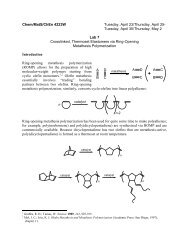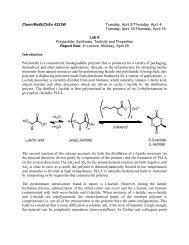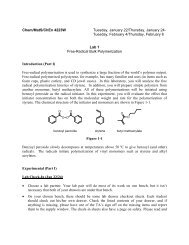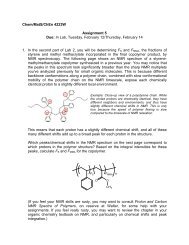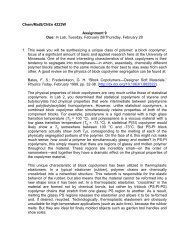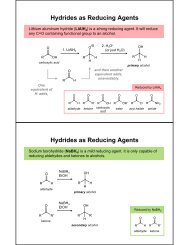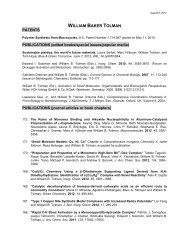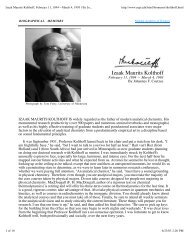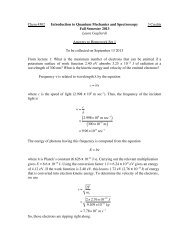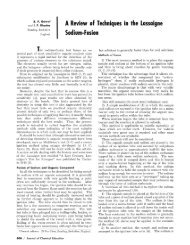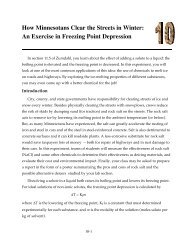Ion-Selective Electrodes With Ionophore-Doped Sensing Membranes
Ion-Selective Electrodes With Ionophore-Doped Sensing Membranes
Ion-Selective Electrodes With Ionophore-Doped Sensing Membranes
Create successful ePaper yourself
Turn your PDF publications into a flip-book with our unique Google optimized e-Paper software.
<strong>Ion</strong>ophore-doped sensing membranes 2567<br />
Sn<br />
Cl<br />
N<br />
N<br />
Br<br />
Co<br />
Py<br />
N<br />
N<br />
N<br />
N<br />
Cl<br />
Mn<br />
N<br />
N<br />
Cl – -II<br />
NO 2 – -I<br />
Cl – -III<br />
Cl<br />
Sn<br />
N<br />
O<br />
N<br />
UO 2<br />
O<br />
Cl<br />
Sn<br />
Sn Cl<br />
Cl<br />
Sn<br />
Phosphate-I<br />
Phosphate-II<br />
A common problem with metalloporphyrin-based ISEs is<br />
relatively high interference from OH − .Indeed,OH − binding<br />
to many metalloporphyrins is so strong that two metallophorphyrins<br />
may bind to one OH − in a sandwichlike 2 : 1<br />
complex. 129 A possible consequence of the high OH − affinity<br />
is a rather complicated potentiometric response mechanism,<br />
as it is illustrated schematically in Figure 24. At<br />
high concentrations of the target anion X − in the aqueous<br />
sample, the sensing membrane doped with a singly<br />
positively charged metalloporphyrin (as typical for metalloporphyrins<br />
with a M(III) metal center) and 33 mol%<br />
anionic sites contains ionophore complexes LX and free<br />
ionophore L + in a ratio 2 : 1 (Figure 24, left). Here, the<br />
ISE will respond to the target anion with the theoretical<br />
(Nernstian response) of −59 mV per 10-fold increase in<br />
the activity of X − in the aqueous phase. When the ISE<br />
membrane is exposed to aqueous solutions of high pH<br />
and low X − activity, ion exchange occurs, and the sensing<br />
membrane contains a 1 : 1 ratio of LOH and [L 2 OH] +<br />
complexes (Figure 24, right). In this concentration range,<br />
the ISE does not respond to X − but only to pH changes.<br />
At intermediate concentrations of X − and OH − in the<br />
sample (Figure 24, center), the sensing membrane contains<br />
a 1 : 1 ratio of LX and [L 2 OH] + . Because there is<br />
no free ionophore in this concentration range, the X −<br />
concentration in the membrane is not buffered well, and<br />
unusual potentiometric responses such as apparently “twice-<br />
Nernstian” response of −116 mV per 10-fold increase in X −<br />
49, 122, 129, 133<br />
at constant pH may be observed in this range.<br />
This increase in response slope may appear attractive, but<br />
Membrane<br />
L + X −<br />
L + X −<br />
L +<br />
R −<br />
L + X −<br />
L + OH − L +<br />
R −<br />
L + OH −<br />
L + OH − L +<br />
R −<br />
Sample<br />
Low pH<br />
high X − activity<br />
High pH<br />
low X − activity<br />
Figure 24 Formation of different ionophore complexes in an ionophore-doped membrane when exposed to sample solutions of<br />
differing hydroxide and target anion concentrations. Note the middle region in which target ion and hydroxide complexes of different<br />
stoichiometry coexist.



